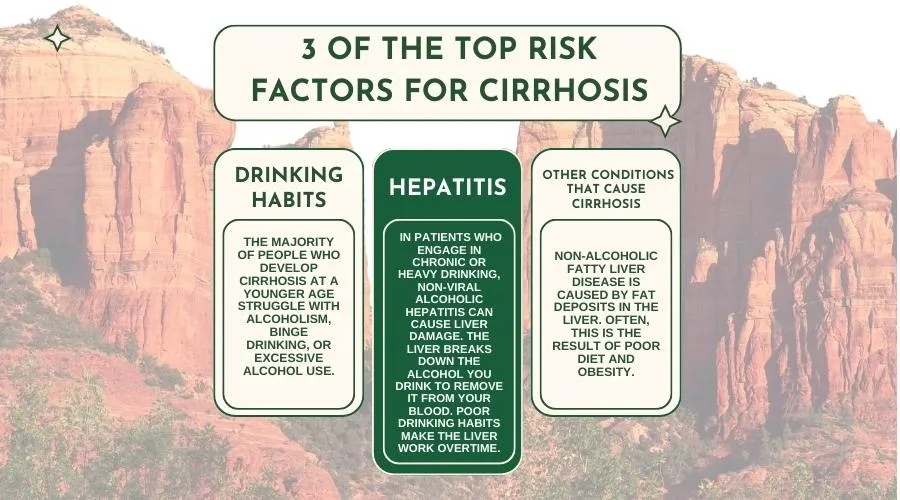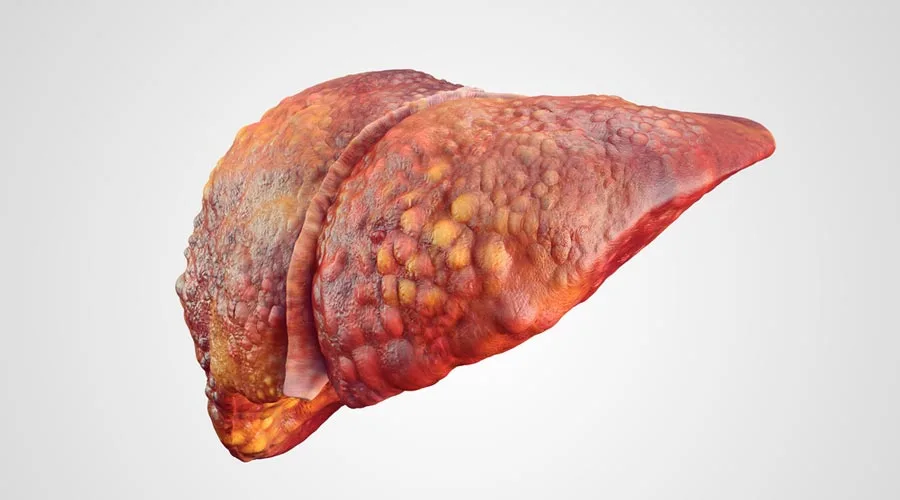Get Answers on Alcohol-Related Liver Disease Among Students
Can young adults get cirrhosis of the liver? According to a 2023 study, the number of young adults with liver disease is higher than ever. While cirrhosis cases were once seen primarily in middle-aged and older patients, approximately 20% of adults in the study were between ages 18 and 40.
Among young adults in this group, 82% of patients presented with cirrhosis caused by chronic or excessive alcohol use. This isn’t the only study of its kind, either.
Being diagnosed with liver damage or alcohol-related liver disease at a young age can be scary – but it can also be treated in many cases.
If this sounds familiar from your own life, or that of your child or loved one, it can feel incredibly overwhelming. But support is available, and help to quit drinking can be found at Catalina.
Below, we will talk more about the diagnosis, treatment, and prognosis of cirrhosis among young people, ways to prevent cirrhosis, and the programs available at Catalina Behavioral Health to give yourself the best possible chance at a positive outcome if a cirrhosis diagnosis has become your reality.
Start Defending Against Cirrhosis Risks Today!
Can Young Adults Get Alcohol-Related Cirrhosis?

Yes, students and younger adults can get cirrhosis – and it is becoming increasingly common. Not only are younger people developing liver problems at a faster rate, but mortality rates from cirrhosis cases in young people are at an all-time high. Liver disease deaths are increasing in all age groups but have a steady increase of about 10% per year in young adults. Over the past few years, several university students and medical research centers have noted this trend.
This study published in 2018 shows a 65% increase in deaths caused by cirrhosis, with adults aged 25-34 having the greatest increase in liver disease death rates beginning in 2009. A 2022 study also showed a steady increase in liver disease and cirrhosis deaths in that age group, this time focusing on 2020 and the years after the pandemic began.
Additionally, stats from the University of Michigan Medical School show a scary truth – in the United States, students and young adults are drinking themselves to death at increasing rates.
Is Cirrhosis Preventable?
Cirrhosis is the end-stage of alcoholic liver disease. Liver disease progresses over time. When the symptoms are identified early enough, better lifestyle habits like avoiding alcohol, improving diet, and losing weight can all help improve liver function. Healthy drinking habits can also prevent liver disease that causes cirrhosis.
For patients diagnosed with liver disease or cirrhosis, it’s important to start these habits as soon as possible. Even though the liver is the only organ that regenerates healthy tissue to heal itself, cirrhosis causes scarring. Once healthy tissue becomes scar tissue, damage can become permanent. Many liver disease deaths are caused by permanent scarring causing liver function to decline.
Young people should focus on prevention before liver damage rather than seeking care after liver damage whenever possible. This means taking control of alcohol use habits and knowing if you need to seek help.
What is Cirrhosis of the Liver?

Cirrhosis of the liver is a chronic liver disease caused by inflammation in the liver. Over time, chronic inflammation leads to scarring and fibrosis that make it harder for the liver to function. As this scarring worsens, patients develop cirrhosis.
Cirrhosis is the stage before end-stage liver disease and liver failure. In cases where scarring is severe, the liver cannot repair itself and a liver transplant may be needed for an individual to survive.
Heavy alcohol consumption can also lead to liver cancer in some patients. Other risk factors for liver cancer include obesity, hepatitis, metabolic disorders, tobacco use, and excessive steroid use.
What is an Alcohol-Related Liver Disease?
Liver disease describes any condition affecting the liver that stops it from functioning as it should. In patients with alcohol-related liver disease, the condition is caused by excessive drinking and alcohol intake.
Frequent and heavy drinking causes inflammation that disrupts the liver from working as it should. Without intervention, this inflammation leads to scarring, liver problems, cirrhosis, and eventually a need for liver transplantation in clients with end-stage liver disease.
What are the Signs of Liver Damage I Might Notice?

The liver plays a critical role in many functions, including metabolizing food, producing proteins, helping with digestion, regulating blood sugar, and excreting bile necessary for removing toxins from medications, alcohol, and your environment from your body.
The signs of liver damage may be slight or seen as ailments rather than signs of something serious. Symptoms to watch out for, especially if you are a heavy drinker, include:
- Swelling and pain in your abdomen
- Pale stool or dark urine
- Loss of appetite
- Nausea and vomiting
- Constant fatigue
- Easy bruising
- Itchy skin
As liver damage advances, you may become more fatigued or sluggish. In severe cases, liver disease patients may experience episodes of confusion, yellowing of the skin or eyes (jaundice), excess fluid in the legs, abdomen, or lungs, and bleeding from the gastrointestinal tract that is likely to appear in stools or vomit. These are severe signs of late-stage liver disease that require immediate medical care.
3 of the Top Risk Factors for Cirrhosis
Cirrhosis and liver damage are often associated with heavy alcohol consumption or drug abuse among young people, however, other factors can contribute to the development of cirrhosis. Viral infections, non-alcoholic fatty liver disease, and alcoholic hepatitis can also increase the risk for cirrhosis.
1) Drinking Habits

The majority of people who develop cirrhosis at a younger age struggle with alcoholism, binge drinking, or excessive alcohol use. It’s not uncommon to blow off steam by having a few drinks with friends. If you are constantly using alcohol to reduce stress in your life, however, it creates a habit that can make it hard to feel normal without drinking.
Some people also drink to relieve stress or when they are feeling depressed, rather than seeking mental health support. This also leads to a vicious cycle of drinking that can make liver damage worse.
The age at which someone drinks alcohol for the first time also influences the development of alcohol-related cirrhosis. Drinking at a young age increases the risk of alcohol problems and damage that contributes to cirrhosis and increased risk of death.
According to recent statistics, young adults aged 12-20 are responsible for 3.2% of alcohol consumption across the United States, and many report binge drinking in unhealthy ways.
Immediate Help For Problem Drinking – Call Now!
2) Hepatitis
Hepatitis causes swelling and inflammation of the liver. Over time, chronic inflammation leads to scarring and potentially irreversible liver damage. As a condition with a main symptom of inflammation, sometimes it is not diagnosed until liver problems are severe.
Viral or non-viral liver conditions lead to liver damage. In patients who engage in chronic or heavy drinking, non-viral alcoholic hepatitis can cause liver damage. The liver breaks down the alcohol you drink to remove it from your blood. Poor drinking habits make the liver work overtime.
Viral hepatitis A, B, C, D, and E are passed from infected individuals, often through contact with the infected person’s blood. While the symptoms can vary, hepatitis B and other conditions all result in inflammation that causes liver damage.
Rates of Hepatitis C are also on the rise, with numbers quadrupling in the last decade. According to the Cleveland Clinic and Center for Disease Control, it is most prevalent in intravenous drug users who share needles.
3) Other Conditions That Cause Cirrhosis
The most common cause of cirrhosis among young adults is heavy or unhealthy alcohol use. In less common cases, cirrhosis among young patients may be caused by diabetes, obesity, poor diet, or viral infections like hepatitis C and B.
Non-alcoholic fatty liver disease is caused by fat deposits in the liver. Often, this is the result of poor diet and obesity. Individuals who consume a lot of processed or fatty foods, have low levels of fiber, and have other poor eating habits are most likely to develop non-alcoholic fatty liver disease.
How is Cirrhosis Treated in Young Adults?

Cirrhosis is one of the advanced stages of liver disease. Often, if you are having symptoms, your primary care physician will refer you to a liver specialist. The course of action depends on the advancement of a person’s liver disease and their lifestyle habits, even with their dietary choices around drinking.
A person who does not stop drinking, for example, is likely to experience complications or rejection if a surgical transplant is considered.
Your willingness to commit to a treatment plan also makes a difference. Continuing with alcohol consumption makes inflammation and the resulting liver damage much worse. This is why it is so important for younger patients with liver diseases to seek help with alcohol consumption habits. Prognosis is increased dramatically by eliminating alcohol from your life.
Can Young Adults Get Cirrhosis: What is the Prognosis After a Diagnosis?
The prognosis following a cirrhosis diagnosis depends on your general health and lifestyle habits, the cause of cirrhosis, and how advanced liver problems are. In one peer-reviewed study, there was a 50% rate of deaths among young people receiving care for cirrhosis for the first time.
However, many of these patients were admitted alcoholics who may not have been able to commit to a healthier lifestyle, even after being aware of the damage done to their liver.
Younger patients also have a better chance of an outcome when they make changes after receiving a liver disease diagnosis. Reach out for help if you cannot stop alcohol use on your own.
Many with liver issues also improve liver health by drinking more water, maintaining a healthy weight, eating better, and avoiding toxins when they can.
Getting Help with Alcohol Dependency After a Cirrhosis Diagnosis
Cirrhosis from alcohol use disorder develops after years of heavy drinking and alcohol abuse. Often, these habits cause your body to become physically and mentally dependent on alcohol. This dependency is the reason many alcoholics experience withdrawal symptoms after quitting alcohol.
At Catalina Behavioral Health, clients can detox from alcohol in a safe environment. Doctors may prescribe medications to manage the symptoms of withdrawal and clients will attend groups, enjoy recreational activities, and have private therapy sessions to help them build the tools to stay sober after leaving the facility.
Outpatient options for alcohol abuse include intensive outpatient programs, partial hospitalization programs, individual therapy, mental health treatment, and support groups like Alcoholics Anonymous.
Is it Possible to Reverse Damage from Alcoholic Liver Disease?

In the early stages, it is possible to reverse the damage from alcoholic liver disease. Unfortunately, many who have a drinking problem do not have it caught in the early stages. In the later stages of alcoholic and fatty liver disease, the inflammation causes irreversible scarring.
Even if this is your reality, many of our former clients have stopped drinking and become eligible for liver transplants, a goal that never would have been achievable without getting sober.
If you are reading this article, and wondering about the damage done by drinking, this very moment is the most opportune time to seek help, so seize the momentum and pick up the phone for support.
Cirrhosis can advance quickly, especially in individuals who continue to make their liver work overtime with continued alcohol use. Every day that you can work toward healing counts with alcoholic liver disease, so don’t hesitate to reach out to Catalina Behavioral Health today!
We Accept Most Major Insurance Providers – Call Now!
Get Support Before or After a Cirrhosis Diagnosis at Catalina
For individuals with early-stage liver disease, getting help at a center like Catalina reduces the risk of complications when detoxing from alcohol. Our programs and therapeutic approaches also give you the chance to address mental health concerns and stress that contribute to drinking and learn coping skills to overcome cravings for alcohol after leaving rehab.
Every day counts when you are diagnosed with cirrhosis or alcoholic liver disease, so please contact our welcoming admissions staff today for a confidential consultation and to get support options now!
References
- https://www.ncbi.nlm.nih.gov/pmc/articles/PMC10088990/
- https://www.bmj.com/content/362/bmj.k2817.long
- https://pubmed.ncbi.nlm.nih.gov/35314353/
- https://my.clevelandclinic.org/health/diseases/15664-hepatitis-c
- https://www.mayoclinic.org/diseases-conditions/nonalcoholic-fatty-liver-disease/symptoms-causes/syc-20354567
- https://www.niaaa.nih.gov/publications/brochures-and-fact-sheets/underage-drinking
- https://www.ncbi.nlm.nih.gov/pmc/articles/PMC8397324/



